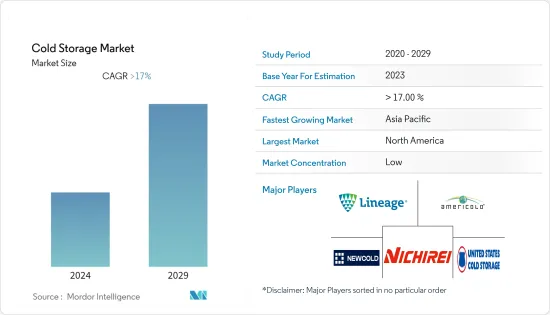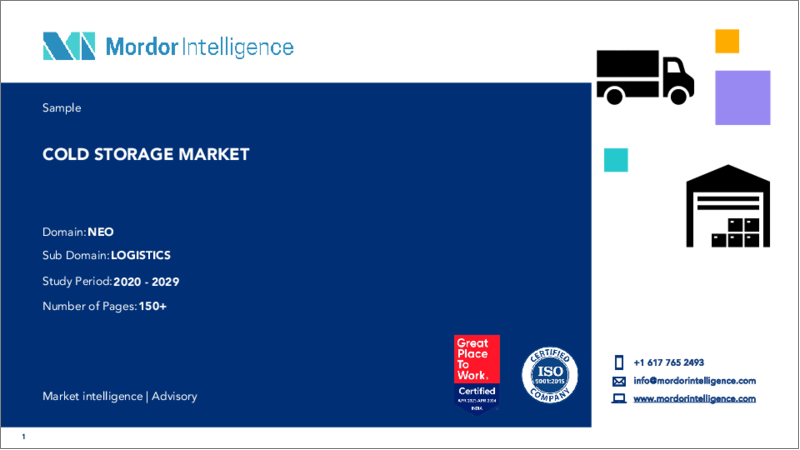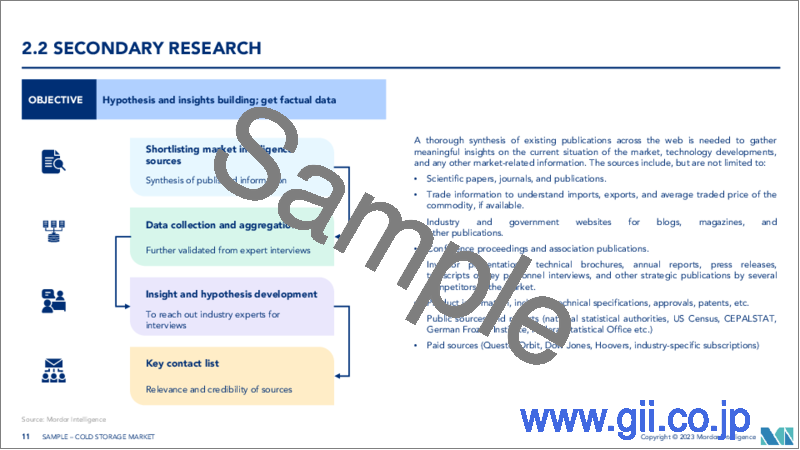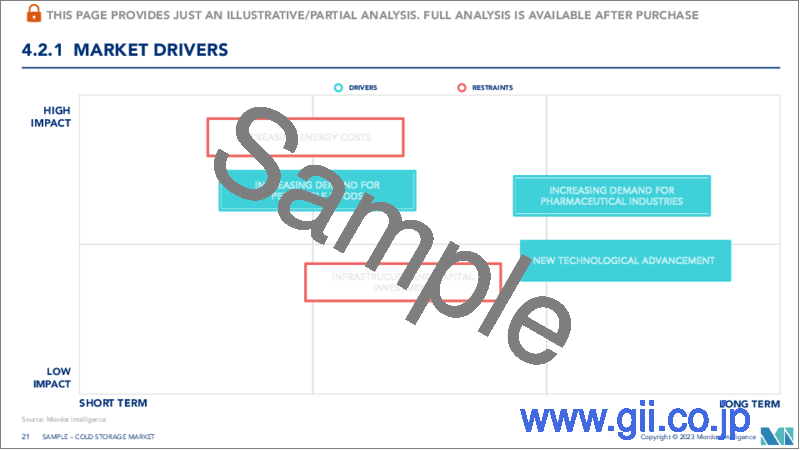|
|
市場調査レポート
商品コード
1408369
冷蔵倉庫:市場シェア分析、産業動向と統計、2024~2029年の成長予測Cold Storage - Market Share Analysis, Industry Trends & Statistics, Growth Forecasts 2024 - 2029 |
||||||
カスタマイズ可能
適宜更新あり
|
|||||||
| 冷蔵倉庫:市場シェア分析、産業動向と統計、2024~2029年の成長予測 |
|
出版日: 2024年01月04日
発行: Mordor Intelligence
ページ情報: 英文 150 Pages
納期: 2~3営業日
|
全表示
- 概要
- 目次
世界の冷蔵倉庫市場規模は2024年に1,902億4,000万米ドルとなり、予測期間中はCAGR17%で成長すると予測されています。
市場は、温度に敏感な製品の生産と供給を管理する厳しい規制から大きな恩恵を受けています。

主要ハイライト
- 同市場の拡大は、商業と産業組織における冷蔵倉庫需要の高まりと、規制遵守の要求に関連しています。拡大の大半は、インド、中国、ブラジル、インドネシア、メキシコなどの新興国で見られます。
- 冷蔵倉庫業界によると、企業の53%が冷蔵倉庫の能力強化を望んでいます。食品や医薬品の需要が増加し、安全性が重視されるようになったことで、冷蔵保管スペースの需要が高まっています。
- 2022年には、冷凍カテゴリーが市場をリードし、世界売上高の約77.3%を占めました。インドや中国などの新興国における冷凍食品消費の増加が、特に冷凍食品業界を後押ししています。このカテゴリーの倉庫は、保管温度を-10ツーF~~20ツーFに保っています。冷凍野菜、果物、魚、肉、魚介類などが保管されています。
- コールドチェーンをサポートするのに必要なインフラがないことは、新興国での成長を目指す企業にとって大きなハードルとなることが予想されます。さらに、輸送ハブや港湾で冷凍トレーラー用の電源フックアップが利用できないことが、これらの地域での産業拡大を妨げる可能性があります。COVID-19は世界の多くの地域で閉鎖や旅行制限を引き起こし、多くの産業のサプライチェーンに影響を与えました。COVID-19の影響は市場に大きな影響を与えました。
冷蔵倉庫市場の動向
食品と医薬品の輸出入の急増
冷蔵倉庫は輸出入の増加により需要が急増しています。世界の貿易の増加と、それに伴う安全な保管インフラへのニーズの高まりにより、冷蔵倉庫市場は活況を呈しています。
インドは世界の医薬品・医療品市場の5.92%を占めています。インドの輸出のほとんど(73.31%)を製剤と生物製剤が占め、医薬品中間体、原薬と続く。2021-22年、インドは前年比2%増の246億2,000万米ドルの医薬品を輸出しました。2020~2021年の輸出額は前年比18%増の244億米ドルでした。
2022年3月、インドは24億米ドル相当の医薬品を輸出し、2022年2月の19億7,000万米ドルから23%増加しました。米国、英国、南アフリカ、ロシア、ナイジェリアがインドの輸出先トップ5です。
2022年12月、中国の医薬品輸出総額は9億9,000万米ドル、輸入総額は32億9,000万米ドルで、貿易赤字は23億米ドルのマイナスとなった。2021年12月から2022年12月にかけて、中国の医薬品輸出は40億3,000万米ドルから9億9,000万米ドルへと30億4,000万米ドル(-75.4%)減少し、輸入は37億1,000万米ドルから32億9,000万米ドルへと4億2,300万米ドル(-11.4%)減少しました。

新たな市場機会を開く再生可能な冷凍技術
冷房は最も急速に成長しているエネルギー使用であるが、今日最も重要なエネルギー議論の盲点のひとつでもあります。冷房需要の増加は電気インフラに負担をかけ、いくつかの国では排出量を押し上げています。欧州委員会の「冷暖房戦略」は、2050年までにEUの気候変動目標を達成するために、冷房の脱炭素化に不可欠な2つの分野として、「自然エネルギーの比率を高める」「産業から排出されるエネルギー廃棄物を再利用する」といった対策を挙げています。その結果、再生可能エネルギーや廃熱を柔軟に「吸収」し、冷房エネルギーに「変換」して貯蔵することで、エンドユーザーのニーズに迅速に対応する新技術の開発と導入が重要になります。
太陽熱を利用した低温貯蔵システムは、ポストハーベスト・ロスを約80%削減し、生鮮食品の保存期間を2日から21日に延ばします。
また、アンモニア(NH3)や二酸化炭素(CO2)のような自然冷媒を使い、畑から熱を集めてコールド・チェーン・プロセスを開始する冷却システムもあります。また、リアルタイムでの負荷監視により、場所、温度、湿度、CO2レベルやドアの開度などの変数に関するデータを収集し、制御を改善することができます。
コールドチェーンを監視・制御する能力を高めることで、重要な変数が品質管理のために設定された範囲から外れた場合にタイムリーな是正措置を取ることができ、損失を回避または削減する機会を提供します。
5G(ユビキタス)モノのインターネットに基づくインテリジェント・システムは、コールドチェーン物流設計における新たな技術です。その技術的な利点により、モノのインターネットは物流分野に浸透し、本来の工業的な形に取って代わりつつあります。これは卸売業者や小売業者が物流を決定するための強固な基盤を提供し、コールドチェーン全体の物流効率を高める上で重要な応用価値を持つ。
冷蔵倉庫業界概要
市場はやや断片化されており、さまざまな地域参入企業が存在しています。これらの市場参入企業は、投資、提携、買収、合併などの手法を通じて市場シェアを拡大しようとしています。また、企業は新製品の開発にも投資しています。さらに、競合価格を維持することにも注力しています。Lineage Logistics Holdings、NewCold、Cloverleaf Cold Storage、Burris Logistics、Americold Logistics LLCが市場の主要参入企業です。
また、Americold Logistics LLCは、世界第4位、欧州第3位の冷蔵倉庫業者であるAgro Merchants Groupの買収により、欧州、南米、米国、オーストラリアでの活動拡大を計画しています。
その他の特典:
- エクセル形式の市場予測(ME)シート
- 3ヶ月間のアナリスト・サポート
目次
第1章 イントロダクション
- 調査の成果
- 調査の前提
- 調査範囲
第2章 調査手法
第3章 エグゼクティブサマリー
第4章 市場力学と洞察
- 現在の市場シナリオ
- 市場力学
- 促進要因
- 抑制要因
- 機会
- バリューチェーン/サプライチェーン分析
- 業界の規制と政策
- 倉庫市場の一般的動向
- 物流分野における技術開発
- 業界の魅力度-ポーターのファイブフォース分析
- 供給企業の交渉力
- 消費者/買い手の交渉力
- 新規参入業者の脅威
- 代替品の脅威
- 競争企業間の敵対関係の強さ
- COVID-19の市場への影響
第5章 市場セグメンテーション
- 建設タイプ別
- バルク貯蔵庫
- 生産貯蔵所
- 港湾
- 温度別
- 冷蔵
- 冷凍
- 用途別
- 果物・野菜
- 乳製品、魚、肉、魚介類
- 加工食品
- 医薬品
- その他
- 地域別
- 北米
- 欧州
- アジア太平洋
- その他
第6章 競合情勢
- 市場集中概要
- 企業プロファイル
- Lineage Logistics Holdings
- Americold Logistics LLC
- The United States Cold Storage
- NewCold
- Nichirei Corporation
- Kloosterboer
- Tippmann Group
- Congebac Inc.
- Snowman Logistics Pvt Ltd
- Burris Logistics
- Cloverleaf Cold Storage
- VX Cold Chain Logistics
- Constellation Cold Logistics*
第7章 市場機会と今後の動向
第8章 付録

The global cold storage market size was valued at USD 190.24 billion in 2024 and is projected to grow at a compound annual growth rate (CAGR) of 17% during the forecast period. The market has benefitted significantly from the stringent regulations governing the production and supply of temperature-sensitive products.
Key Highlights
- Its expansion can be linked to rising demand for cold storage in commercial and industrial organizations, as well as regulatory compliance demands. The majority of the expansion was seen in emerging nations such as India, China, Brazil, Indonesia, and Mexico, among others.
- According to the cold storage industry, 53% of enterprises want to enhance their cold storage capacity. Increasing demand for food and pharmaceuticals, as well as a greater emphasis on safety, has resulted in a rise in demand for cold storage space.
- In 2022, the frozen category led the market, accounting for around 77.3% of worldwide sales. Increasing frozen food consumption in emerging nations such as India and China is pushing the frozen food industry in particular. Warehouses in this category keep their storage temperatures between -10°F and -20°F. They hold frozen vegetables, fruit, fish, meat, seafood, and other items.
- The absence of infrastructure necessary to support the cold chain is expected to provide a significant hurdle for enterprises looking to grow into emerging economies. Furthermore, the unavailability of power hook-ups for reefer trailers at transportation hubs and ports may stymie industry expansion in these areas. COVID-19 caused lockdowns and travel restrictions in numerous regions of the world, affecting the supply chains of many industries. The consequences of COVID-19 have had a considerable impact on the market.
Cold Storage Market Trends
Rapid Growth in Import and Export Activities of Food Items and Pharmaceutical
Cold storage facilities are witnessing rapid growth in demand owing to the increasing import and export activities. The cold storage market is booming with increasing global trade and the corresponding need for secure storage infrastructure.
India accounts for 5.92% of the worldwide pharmaceutical and medicine market. Formulations and biologics accounted for most of India's exports (73.31%), followed by drug intermediates and bulk medicines. In 2021-22, the country exported pharmaceutical items worth USD 24.62 billion, a 2% increase over the previous year. Exports increased by 18% yearly to USD 24.4 billion in 2020-21.
In March 2022, India exported USD 2.4 billion worth of drugs and pharmaceuticals, a 23% increase from USD 1.97 billion in February 2022. The USA, UK, South Africa, Russia, and Nigeria are India's top five export destinations.
In December 2022, China's pharmaceutical product exports totalled USD 990 million, while imports totaled USD 3.29 billion, resulting in a USD 2.3 billion negative trade deficit. From December 2021 and December 2022, China's pharmaceutical exports fell by USD -3.04B (-75.4%) from USD 4.03B to USD 990M, while imports fell by USD -423M (-11.4%) from USD 3.71B to USD 3.29B.

Renewable Refrigeration Technologies to Open New Market Opportunities
Cooling is the fastest-growing energy use, but it is also one of the most crucial energy debate blind spots today. Rising cooling demand is putting a strain on electrical infrastructure and pushing up emissions in several countries. The European Commission's Heating and Cooling Strategy mentions measures such as "raising the percentage of renewables" and "reuse of energy waste from industry" as two essential areas for decarbonizing cooling to meet the EU's climate objectives by 2050. As a result, new technology development and adoption are critical to meet end users' needs promptly by flexibly 'absorbing' renewable energy and/or waste heat and then 'converting into' and storing cooling energy.
Solar-powered cold storage systems reduce post-harvest loss by roughly 80% and increase the shelf life of perishable foods from two to 21 days.
There are also cooling systems that use natural refrigerants like ammonia (NH3) or carbon dioxide (CO2) to collect heat from the field and start the cold chain process. Load monitoring in real time also enables the collection of data on location, temperature, humidity, and other variables such as CO2 levels or door opening to improve control.
Increasing the capacity to monitor and control the cold chain allows for timely corrective actions to be taken when a critical variable departs from the ranges established for quality control, providing the opportunity to avoid or reduce losses, while registration itself, the log of conditions throughout the chain, allows the parties involved to validate that the products were kept in the required conditions.
Intelligent systems based on the 5G (ubiquitous) Internet of Things are an emerging technology in the design of cold chain logistics. With its technological benefits, the Internet of Things is infiltrating the logistics area and replacing the original industrial shape. This provides a solid foundation for wholesalers and retailers to make logistical decisions, and it has significant application value for increasing the logistics efficiency of the whole cold chain.
Cold Storage Industry Overview
The market is somewhat fragmented, with various local players present. These market participants are attempting to increase their market share through techniques such as investments, collaborations, acquisitions, and mergers. Businesses are also investing in the creation of new products. Furthermore, they are concentrating on keeping competitive pricing. Lineage Logistics Holdings, NewCold, Cloverleaf Cold Storage, Burris Logistics, and Americold Logistics LLC are the market's leading participants.
Americold Logistics LLC also plans to extend its activities in Europe, South America, the United States, and Australia with the acquisition of Agro Merchants Group, the world's fourth-biggest cold storage operator and the third-largest in Europe.
Additional Benefits:
- The market estimate (ME) sheet in Excel format
- 3 months of analyst support
TABLE OF CONTENTS
1 INTRODUCTION
- 1.1 Study Deliverables
- 1.2 Study Assumptions
- 1.3 Scope of the Study
2 RESEARCH METHODOLOGY
3 EXECUTIVE SUMMARY
4 MARKET DYNAMICS AND INSIGHTS
- 4.1 Current Market Scenario
- 4.2 Market Dynamics
- 4.2.1 Drivers
- 4.2.2 Restraints
- 4.2.3 Opportunities
- 4.3 Value Chain / Supply Chain Analysis
- 4.4 Industry Policies and Regulations
- 4.5 General Trends in Warehousing Market
- 4.6 Technological Developments in the Logistics Sector
- 4.7 Industry Attractiveness - Porter's Five Forces Analysis
- 4.7.1 Bargaining Power of Suppliers
- 4.7.2 Bargaining Power of Consumers/Buyers
- 4.7.3 Threat of New Entrants
- 4.7.4 Threat of Substitute Products
- 4.7.5 Intensity of Competitive Rivalry
- 4.8 Impact of COVID-19 on the Market
5 MARKET SEGMENTATION
- 5.1 By Construction Type
- 5.1.1 Bulk storage
- 5.1.2 Production stores
- 5.1.3 Ports
- 5.2 By Temperature
- 5.2.1 Chilled
- 5.2.2 Frozen
- 5.3 By Application
- 5.3.1 Fruits & Vegetables
- 5.3.2 Dairy, Fish, Meat, & Seafood
- 5.3.3 Processed Food
- 5.3.4 Pharmaceuticals
- 5.3.5 Others
- 5.4 By Geography
- 5.4.1 North America
- 5.4.2 Europe
- 5.4.3 Asia Pacific
- 5.4.4 Rest Of the World
6 COMPETITIVE LANDSCAPE
- 6.1 Market Concentration Overview
- 6.2 Company Profiles
- 6.2.1 Lineage Logistics Holdings
- 6.2.2 Americold Logistics LLC
- 6.2.3 The United States Cold Storage
- 6.2.4 NewCold
- 6.2.5 Nichirei Corporation
- 6.2.6 Kloosterboer
- 6.2.7 Tippmann Group
- 6.2.8 Congebac Inc.
- 6.2.9 Snowman Logistics Pvt Ltd
- 6.2.10 Burris Logistics
- 6.2.11 Cloverleaf Cold Storage
- 6.2.12 VX Cold Chain Logistics
- 6.2.13 Constellation Cold Logistics*





